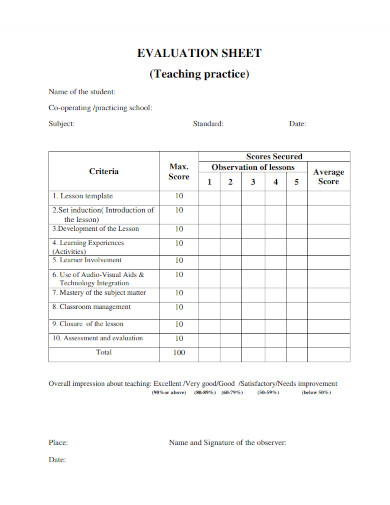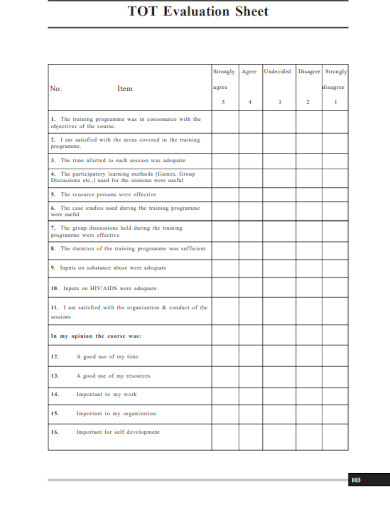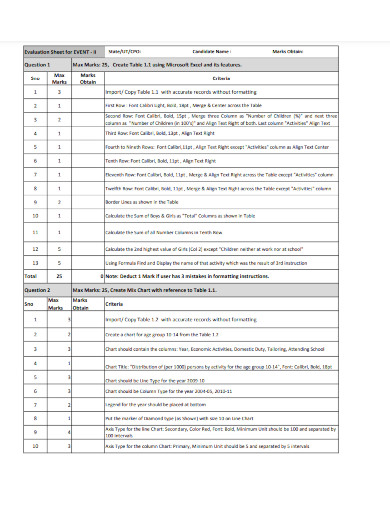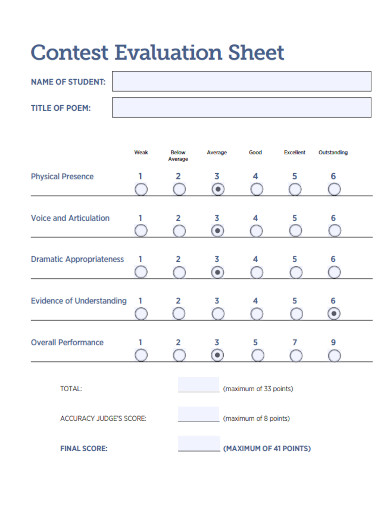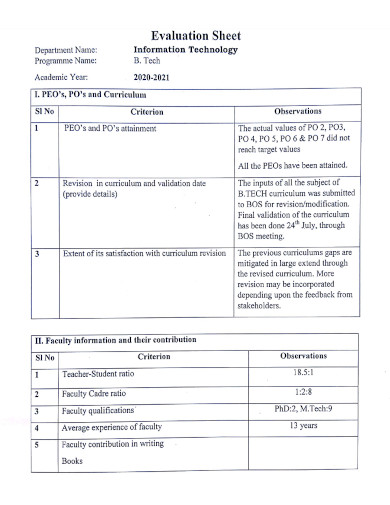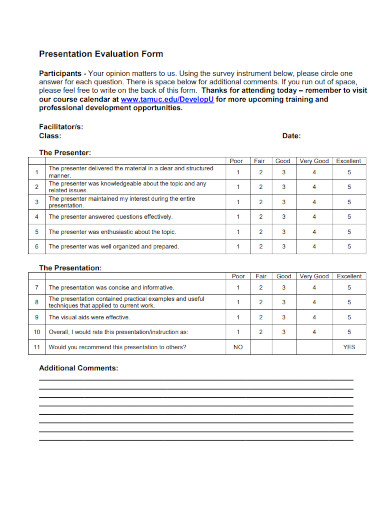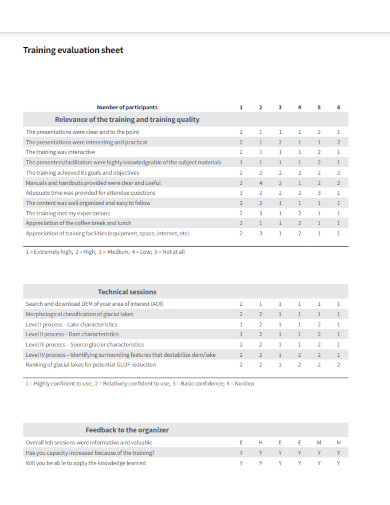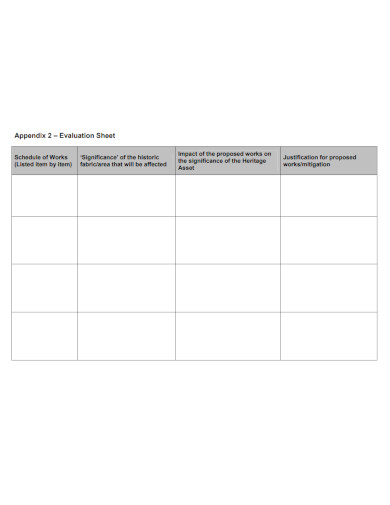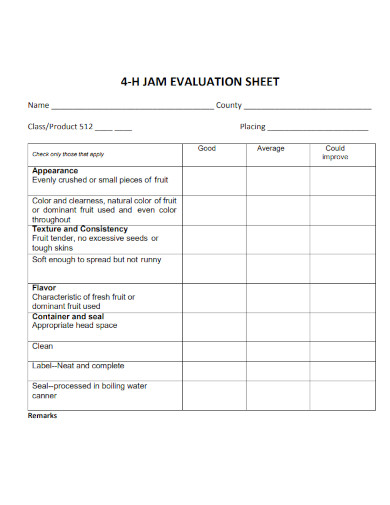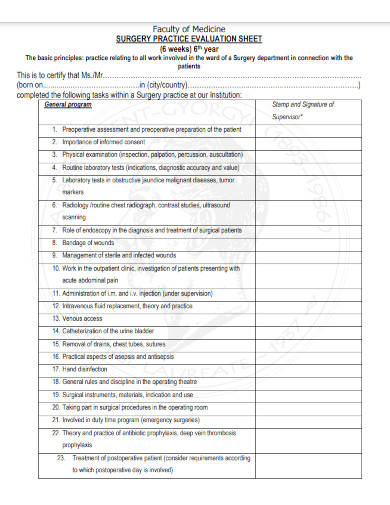Most professionals will use an evaluation sheet at some point in their employee performance, either as the one doing the assessment or as the one being assessed. Depending on who prepares the form, evaluations may require the evaluator’s identity or be anonymous, and they may be in paper copy or digital form. Understanding these documents better will enable you to compose one as a business manager or comprehend your evaluation as a team member or new employee. Moreover, it contains pertinent data that might aid the business in making decisions on career promotions, salary sheet contents, and layoffs. Employers may also mention the strengths and flaws of their staff on an evaluation form.
10+ Evaluation Sheet Samples in PDF
1. Evaluation Sheet Template
2. TOT Evaluation Sheet
3. Evaluation Sheet of Event
4. Contest Evaluation Sheet
5. Evaluation Sheet Template
6. Presentation Evaluation Sheet
7. Training evaluation sheet
8. Sample Evaluation Sheet
9. Jam Evaluation Sheet
10. Proposal and Interview Evaluation Sheet
11. Surgery Practice Evaluation Sheet
What Is Evaluation Sheet?
Professionals might use an evaluation sheet as a tool for giving and receiving feedback. Typically, it has questions that aid the person in filling out the form. They might use the questions as a springboard to assess, comment on, and express ideas about another individual through feedback evaluation. Several scenarios with various instances, places, and methods can use an evaluation sheet. While some assessments are used to ensure or improve an individual’s proper daily work performance in a professional working setting, others are utilized for academic purposes.
How To Make an Evaluation Sheet?
The secret to a successful employee assessment form is to ensure that all the relevant data is gathered on a single, simple sheet. Once you’ve determined which performance-related and quality assessment factors are significant to you, ensure the form adequately reflects those factors, either through a numerical scale or an open-ended form for more in-depth input. Besides, you can successfully evaluate the quality of work of anyone through a monthly or quarterly evaluation sheet of your choice.
1. Name
This field might be used to record the evaluator’s name. The name of the subject of the evaluation could also be collected. The evaluator may decide to skip writing their name if the review is anonymous to protect their identity.
2. Contact Information
This field has to do with the assessor. Your contact information could make it easier to follow up with the subject of the evaluation and resolve any issues between the evaluator and the subject of the evaluation. Additionally, it guarantees that they hold the assessor responsible for any comments made on the form.
3. Rating Scale
It is quite likely that the form also includes a rating scale if it asks the evaluator to select a number from a scale. This grading system aids in the decision-making process and ensures uniformity in the evaluation of the staff. Since it is simple and not unduly demanding, a five-point scale is frequently used, but other values are also suitable. If you would rather the evaluator refrain from providing average scores for all employees, choose an even-numbered rating scale.
4. General remarks
The form is made more adaptable with this field. Including a section for general remarks may be beneficial since it gives the evaluator the chance and space to offer additional commentary regarding the subject of the evaluation that the form’s developer may not have considered. Some assessors might also take advantage of this chance to compliment the subject of the assessment or express gratitude for their efforts. These remarks could be quite encouraging and motivate the subject of the assessment to put in more effort.
What does an evaluation form serve?
Giving “valuable input” to a range of audiences is the primary goal of the assessment form. Besides providing insight into past or current projects, useful feedback typically encourages contemplation and aids in discovering future change.
What three categories of evaluation exist?
Process, impact, outcome, and summative evaluations are the main categories of evaluation.
Which two fundamental sorts of evaluation are there?
Formative and summative evaluations are two different types of evaluation that are not exclusive of one another. Many assessments mix the two. But frequently, only one goal predominates. A formative evaluation is typically conducted throughout a project or program, frequently at the halfway point.
Utilizing evaluation forms is a terrific approach to get insightful input and pinpoint areas that require development. Our free online Evaluation Forms will make it simpler to collect and track evaluations, whether you want to collect data on customer satisfaction, student development, employee performance, or visitor input.
Related Posts
FREE 10+ Dependability Evaluation Samples in PDF | DOC
FREE 10+ Quantity of Work Evaluation Samples [ Employee, Self, Performance ]
FREE 10+ Heuristic Usability Evaluation Samples [ Website, Testing, Inspection ]
FREE 10+ Job Knowledge Evaluation Samples [ Employee, Skills, Self ]
FREE 10+ Consultant Performance Evaluation Samples in PDF | DOC
FREE 10+ Job Interview Evaluation Samples [ Teacher, Candidate, Performance ]
FREE 10+ Grant Proposal Evaluation Samples in PDF | DOC
FREE 10+ Faculty Performance Evaluation Samples in PDF | DOC
FREE 10+ Internship Evaluation Samples [ Supervisor, Self, Performance ]
FREE 10+ Resident Evaluation Samples [ Medical, Self, Rotation ]
FREE 10+ Dissertation Evaluation Samples [ Critical, Service, Self ]
FREE 3+ Front Desk Evaluation Samples [ Performance, Receptionist, Employee ]
FREE 10+ Vendor Performance Evaluation Samples in PDF | DOC
FREE 10+ Thesis Evaluation Samples [ Master, Defense, Project ]
FREE 10+ Student Evaluation Samples [ Teacher, Self, Performance ]
